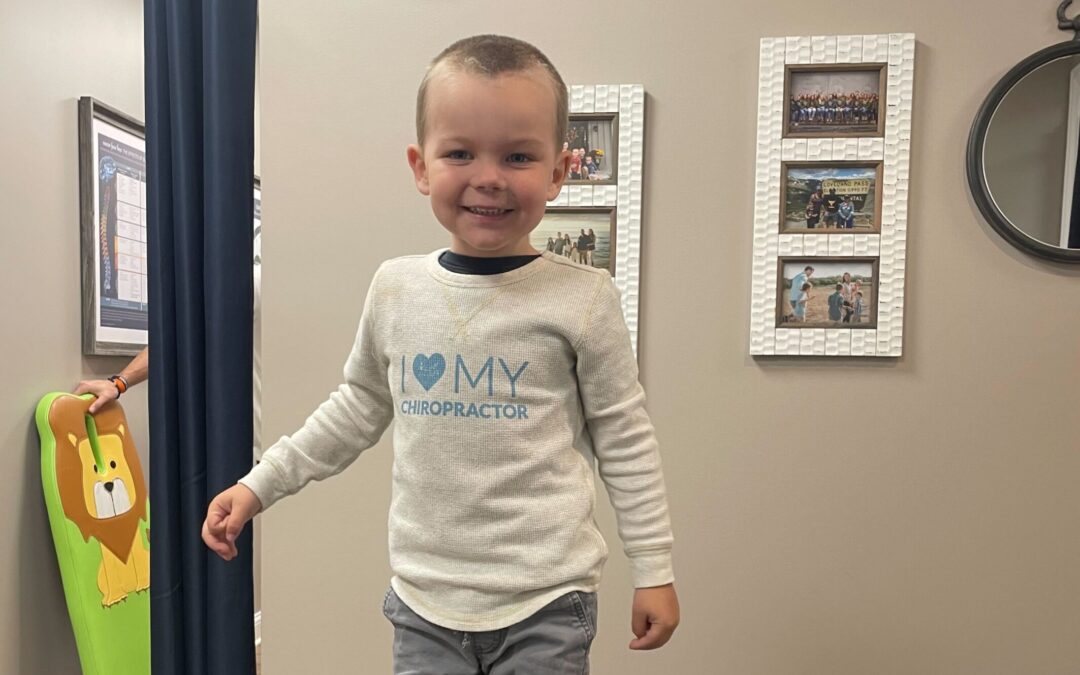There is nothing more exciting than that special moment when a mom + dad first find out they’re pregnant and expecting! When those two little lines show up on the pregnancy test, the emotions are truly indescribable.
What is also almost impossible to explain is how truly miraculous it is that those two simple cells can combine as they do and, around 40 weeks later, have multiplied and developed into a beautiful human baby with organs and limbs, eyes and ears, all the way to fingernails and eyelashes.
If you truly want to be blown away, slow down for just a second while reading this article and think about all that must happen, in a perfectly orchestrated fashion, for that beautiful baby to develop healthy and full in time for birth.
In order for all this to happen throughout the pregnancy, there must be perfect harmony and organization from the moment conception happens. And all of that organization and growth, officially termed fetal development, happens under the direction and control of the nervous system.
In this article, we’re going to dive deep into fetal development and the massive role it plays in determining health outcomes for the child throughout life. We’ll take an extra deep dive into the role of what’s called the Vagus Nerve and Autonomic Nervous System, which by far and away play a more important role in the growth and development of the child than any other system or structure.
While most of us are led to believe that the health of our children is determined by DNA and their genetic code, fascinating new research and clinical observations tell us that in reality the health of a developing child’s nervous system and the environment they are developing in throughout pregnancy and childhood play a far greater role in determining their health than their DNA.
What you’re about to learn is that the Vagus Nerve plays a vital role throughout development in utero, and then stays on the job throughout overall childhood development. While so many parents and professionals have been told to look at things like genetics, lab work, and gross motor development to determine overall brain and neurodevelopment in a child, this article will help us understand that perhaps we’ve been looking in the wrong place for the most accurate and useful information all along. In this article, we’ll focus primarily on the role of the Vagus Nerve in fetal development throughout pregnancy.
What is Fetal Development?
To start, we need to understand what fetal development is. Maybe you remember back to science class where the teacher talked about zygomatic cells, eggs, sperm, and mitosis. Fetal development refers to the process by which a fertilized egg, or zygote, undergoes a series of stages to become a fully formed baby.
Even if you don’t recall any of those terms from back in biology class, don’t worry because we’re going to move our focus off of commonly taught things like genetic code and cell replication, and focus instead on the critical process and important stages of neurological development through the vagus nerve and autonomic nervous system.
These intricate processes occur throughout pregnancy and are marked by distinct milestones and changes, measured week-by-week for 40+ weeks. While most measure the development of a healthy pregnancy through things like ultrasounds, measurements, lab work, and so forth, we’ll shift your perspective here in this article and introduce a new form of incredible technology that can actually help measure and track the development of the most important system of all – the nervous system.
The Role Of The Nervous System In Fetal Development and Prenatal Health
A regulated and well-balanced nervous system is of utmost importance during pregnancy for both mom and baby. The nervous system acts as the master control center, coordinating and regulating all functions. Most importantly, during the prenatal period, the mother’s nervous system acts as the “conductor” for the child’s nervous system development as well.
Put simply, this means that any distress, anxiety, or big emotional challenges that the mother faces during this sensitive period of development, the child experiences them as well.
What we now know is that higher levels of maternal distress such as the loss of a loved one, high-stress jobs, relationship stress, or even natural disasters and socioeconomic disruption can alter the neurodevelopment of the child and show up as all sorts of health challenges later on in life. What used to be just observed clinically has now been documented and discussed again and again in various research studies like this one here.
Think of the umbilical cord connecting mom and baby as more than just a passageway for blood flow and nutrients or toxins to pass along to the child, but also as the “electrical power cord” that connects mom’s nervous system to baby’s. So if the mother is constantly exposed to stress and anxiety, that chronically activates her sympathetic nervous system, and that stress is then passed on to the developing child.
With this article, we are looking to dive even deeper into the neurological and physiological connections between maternal distress and child development, and we can do so by further discussing three crucial components of this important conversation:
- Optimal Autonomic Nervous System Development
- The Vagus Nerve
- Heart Rate Variability (HRV) Technology
Let’s start with optimal or ideal nervous system development.
Autonomic Nervous System and Vagus Nerve Development
Starting off with a simple take on fetal development, we know that things develop over three (3) main phases or layers. The first layer to develop is the nervous system and brain. The second layer will be the major organs, such as the digestive system and lungs. The third layer will be the heart, blood system, muscles, and skeleton.
This shows us the main take-home of the entire article – optimal development of the nervous system is vitally important for the development of everything else downstream, from digestion to immune function to cognitive brain development, and so much more. If the nervous system is thrown off track early during the sensitive developmental periods, then all sorts of health challenges can develop later on in life for the child.
Taking an even closer look at the Autonomic Nervous System (ANS) and Vagus Nerve specifically, it starts to develop as early as 3-4 weeks. Here are the main elements of this development:
3 weeks:
• Start of Autonomic Nervous System Development
4 weeks:
• Organogenesis
– Brain regions, vesicles, glial cells, meninges
– Diaphragm and heart
4-8 weeks:
• Cranial nerves
• Intestinal and celiac ganglia
6 weeks:
• First parasympathetic ganglia
– Lays the foundation for social development
10 weeks:
• Sympathetic trunks
• Enteric Nervous System (ENS) innervation complete
11 weeks:
• All facial reflexes
• Spinal reflexes
• Awake and asleep
• Brainstem is ON
13 weeks:
• The growing baby is more susceptible to maternal and environmental factors
17 weeks:
• Cerebellum forms
20 weeks:
• Nociception Myelination
– First external proprioception
– Amniotic fluid and lanugo
26 weeks:
• Control body temperature
• Vagus Nerve myelination
32 weeks:
• The left and right brain sync together
37 weeks:
• ANS fully develops
37-38 weeks:
• Sympathetic Nervous System outflow from Central Autonomic Network (CAN) to support baby in birth
40 weeks:
• Vagus and Cholinergic Anti-inflammatory Pathway (CAP) function before and after birth
– Predict the quality of recovery from birth (surgeries, inflammation, interventions, etc)
Now that may be a whole lot of nerdy neurological information for parents to read, but that’s really the take-home point – it’s all very intricate, important, and interconnected!
Ensuring the healthy development of the ANS during fetal development sets the foundation for the lifelong functioning of these regulatory systems.
Nervous System Regulation
Here are some of the key reasons why ANS and Vagus Nerve development is essential for the development of overall regulation and essential life functions:
- Regulation of Vital Functions:
- The ANS regulates essential bodily functions such as heart rate, respiratory rate, and blood pressure. Proper development ensures the fetus can adapt to changing conditions and maintain stability.
- Oxygen and Nutrient Supply:
- Adequate ANS development is essential for regulating blood flow to different organs, ensuring that the fetus receives a sufficient oxygen and nutrient supply for optimal growth and development.
- Temperature Regulation:
- The ANS contributes to the regulation of body temperature. Maintaining an appropriate temperature is crucial for the proper development of organs and tissues.
- Digestive Processes:
- The ANS controls digestive processes, including peristalsis and nutrient absorption. Proper digestion is vital for providing the fetus with essential nutrients for growth.
- Stress Response:
- The ANS is involved in the stress response, helping the fetus respond to various stimuli. An appropriately developed ANS contributes to the ability to handle stressors in the intrauterine environment.
- Neurological Development:
- The ANS is interconnected with the central nervous system (CNS), and their coordinated development is crucial for overall neurological functioning. This includes the development of reflexes and sensory responses.
- Formation of Neural Connections:
- Neural connections within the ANS and between the ANS and CNS undergo intricate development. This connectivity is vital for proper communication between different parts of the nervous system.
- Behavioral and Emotional Regulation:
- The ANS plays a role in regulating behavioral and emotional responses. Developing appropriate ANS functions contributes to emotional regulation and responsiveness.
- Fetal Movement Coordination:
- Coordinated movements of the fetus, including spontaneous movements and responses to stimuli, are influenced by the ANS.
- Immune System Function:
- There is a growing understanding of the interaction between the ANS and the immune system. Proper ANS development may contribute to the establishment of a balanced immune response.
Disruptions in ANS and Vagus Nerve development can potentially lead to various health challenges for the developing child and may contribute to long-term health issues.
Therefore it’s important that our maternal and family healthcare model catch up to the latest understanding of optimal child development and find a way to measure and care for mother and child during pregnancy that moves way beyond simple lab tests and ultrasounds.
Thankfully that technology already exists and has a strong foundation of research and science behind it, with more coming out every day! That technology is called Heart Rate Variability, or HRV for short, and just like this incredible paper shows and discusses, it very well could be the most important test for an expecting mother to have consistently performed throughout her pregnancy.
The two images below show an HRV of a pregnant patient before and 12 visits into her care plan at her PX Doctor. The first HRV graph shows and wound-up and worn-out momma who is in the first trimester, creating a baby from scratch! Her nervous system had been stuck on the gas for so long that it was becoming exhausted. Any stress that came her way would make her nervous system crash, leading to exhaustion and sickness. The second HRV graph shows that the expectant mother shows that her body battery is now full, she has way more energy and gas in the tank. The goal is for the white dot to be in the green zone, and we can see that throughout her customized care plan, she is getting closer to the green! This momma’s nervous system is now more resilient and ready to take on birth and the other challenged and joys that come along with having a newborn!
The Role Of Maternal Stress On Fetal Autonomic Nervous System Development
Maternal health plays a major role in fetal development, especially when it comes to the ANS and Vagus Nerve. The umbilical cord brings nutrients, oxygen, and blood supply to the baby in utero, but as discussed above it is also the baby’s power cord and essential neurological connection to mom. Meaning, anything that Mom experiences, so does the baby. This is why it is so important to focus on mom’s health because it also significantly impacts the developing baby as well.
The baby’s nervous system starts to develop before most of us find out we are even pregnant, which is why preconception health is very important. We can start caring for ourselves and the baby even before the baby is conceived. The goal is for both partners to be their healthiest selves so they can create a healthy baby.
The number one cause of preconception and fertility struggles is a dysregulated nervous system, which then can lead to a cascade of challenges with hormones and other important physiological systems that play a vital role in conception and pregnancy. The same can be said for complications within pregnancy.
While experiencing occasional stress in traffic, at work, with family, and throughout life is absolutely normal and something we are programmed to easily adapt to and handle, in today’s world our expecting mothers are experiencing higher levels of sustained, chronic stress than ever before.
And sadly, our current medicalized system of prenatal care only adds to that stress, leading to fear, anxiety, and disempowerment. It seems that with each and every visit to the doctor, additional ultrasounds, testing, and other exams can immensely add to that stress for both mom and baby.
In today’s medicalized world, it almost seems like we are “diagnosing” moms as pregnant and treating them as if they have a medical condition that needs constant monitoring and oversight instead of consistent support, encouragement, and nourishment.
If going forward we can switch the standard model of prenatal care to be one that routinely checks in on an expecting mother’s stress levels and HRV, we can then have a much better idea of where the child’s neurological development is headed, and provide supportive measures for both mom and baby before the sympathetic stress storm sets in. We will discuss that final neurological component next.
The Role of Stress, Subluxation, and Dysautonomia in Child Development
When someone is exposed to prolonged periods of excessive stress, it leads to something called subluxation and sympathetic dominance. When subluxation is present, the entire nervous system shifts into an excessive sympathetic dominant state, which then in turn creates suppression or a “shutting down” effect on the parasympathetic nervous system and vagus nerve. This overall neurological imbalance is called dysautonomia.
This neurological imbalance and sustained state of stress can then throw the entire ANS and vagus nerve development off track, leading to neurological delays and dysfunction before the child is even born. However, many of these challenges will not show up symptomatically for many weeks, months, or even years down the road.
Can You Measure This Stress? Introducing HRV To Fetal Development And Pregnancy Care
Just like pregnancy is supposed to be an exciting and empowering experience, we can now turn the tone of this article towards an exciting new care option for expectant mothers – monitoring and managing their neurological health via HRV Technology and Neurologically-Focused Prenatal Chiropractic Care!
Now that the research has shown us how important taking care of our stress levels and neurological health is for both mom and baby, it’s exciting to know that we have this incredibly easy and effective technology called HRV to help us track and measure how we’re doing. Heart Rate Variability provides valuable insights into the health and function of the autonomic nervous system and vagus nerve for mom, and therefore the development of those essential components for baby.
Numerous research studies have measured the baby’s HRV in utero through their heart rate. This is amazing because studies show that there is a correlation between a mother’s HRV and baby’s as well. This is why it is important for mom’s HRV to be the highest it can be to help enhance proper fetal development.
Think of HRV as not only a measure of neurological balance but also your “battery power” and how adaptable and resilient your nervous system is. While pregnant, mom’s autonomic nervous system and vagus nerve not only need to regulate and control all of her vital bodily functions, but also then regulate and control the development and function of all the baby’s essential tissues, organs, and cells. That’s a lot of hard work for one nervous system to do, so keeping it constantly balanced and “charged” is essential for both mom and baby’s well-being and optimal outcomes after birth as well.
The Impact Of HRV On Fetal Development
HRV is a measure of the variation in time between consecutive heartbeats.
Lower HRV in utero can be associated with several outcomes, although it’s essential to note that research in this area is ongoing, and specific causal relationships may vary. Here are numerous associations with lower fetal HRV:
- Fetal Distress:
- Lower HRV in utero can be a sign of fetal distress.
- Preterm Birth:
- Lower fetal HRV is associated with an increased risk of preterm birth. Preterm birth can lead to a range of health challenges for the newborn.
- Neurodevelopmental Issues:
- Some studies have explored the link between fetal HRV and later neurodevelopmental outcomes. Lower HRV has been associated with conditions such as attention deficit hyperactivity disorder (ADHD) and other cognitive and behavioral issues.
- Cardiovascular Health:
- Lower HRV might be indicative of disturbances in development and could potentially have implications for long-term cardiovascular health.
- Maternal Stress:
- Maternal stress during pregnancy can impact fetal HRV. Lower HRV might reflect exposure to chronic stressors during pregnancy, which can have both immediate and long-term consequences for the child’s health.
- Resilience to Stress:
- Fetal HRV has been studied in the context of stress resilience. Lower HRV may indicate a reduced ability to adapt to stressors, potentially influencing the child’s response to stress later in life.
Higher HRV in utero is generally considered a positive sign and is associated with several favorable outcomes. Here are some potential positive implications:
- Healthy Autonomic Nervous System (ANS) Development:
- Higher fetal HRV suggests a well-developed Autonomic Nervous System that is balanced between sympathetic and parasympathetic branches.
- Optimal Oxygenation and Nutrient Delivery:
- Adequate HRV in utero indicates that the fetus is receiving optimal oxygenation and nutrient delivery through the placenta. This is essential for proper growth and development.
- Normal Fetal Movement and Activity:
- Fetal movement and activity are regulated by the ANS. Higher HRV is associated with normal variations in fetal heart rate, indicating appropriate responses to stimuli and movements.
- Reduced Risk of Fetal Distress:
- Higher HRV is often associated with a reduced risk of fetal distress. A healthy autonomic response helps the fetus adapt to changes in the intrauterine environment, minimizing the risk of complications.
- Stronger Cardiovascular Health:
- Adequate HRV during fetal development is linked to better cardiovascular health later in life. It reflects the adaptability and resilience of the cardiovascular system.
- Positive Neurodevelopmental Outcomes:
- Some research suggests a connection between higher fetal HRV and positive neurodevelopmental outcomes. This may include better cognitive and behavioral functions in childhood.
- Reduced Risk of Preterm Birth:
- In some studies, higher fetal HRV has been associated with a reduced risk of preterm birth. Preterm birth is linked to various health challenges, and maintaining a healthy autonomic balance is crucial for preventing early labor.
How We Track HRV During Pregnancy For Fetal Development
Measuring and tracking true autonomic nervous system and vagus nerve functions are the foundation of our work as PX Docs. The HRV exam is one of three (3) components of our incredible INSiGHT Scans, which measure the overall stress, dysfunction, and imbalance within the autonomic nervous system of our pregnant patients.
By checking for things like nervous system dysregulation, subluxation, and dysautonomia we can find exactly where a mother’s nervous system may be stuck in that sympathetic stress mode, and to what degree. Our INSiGHT Scans provide not only a valuable starting point and help us develop a personalized and customized care plan to optimize neurological function and vagal nerve tone for expecting mothers, but we can also use them to continue to track and monitor nervous system regulation and health throughout the pregnancy and in the postpartum phase as well.
What’s really fascinating and exciting is that not only do we continue to see higher HRV findings correlate with more positive pregnancy and birth outcomes for mom, but also a higher HRV and neurological health status for babies once they arrive! Our HRV technology can be performed on the infant within a matter of just a few minutes to a few days as well, and we continuously see connected neurological patterns between mom and baby as we measure and support both of their nervous systems in the few weeks and months of life after birth.
Once we have these incredible INSiGHT Scans done, we can then put together a fully customized and personalized Care Plan made uniquely for the expecting momma. Once care begins, every Neuro-Tonal Adjustment our doctors are trained to make is designed to address subluxation and dysautonomia directly.
How To Get The Help You Need
As we’ve discussed all along, we do live in a highly stressful and busy environment these days. Many expecting mothers do find themselves more frequently stressed out, anxious, and exhausted than they’d like, and it frequently shows on their initial HRV exam in our offices.
However, this provides for an exciting opportunity to help mom get ahead of her stress and start to rebalance and recharge the autonomic nervous system and vagus nerve through what are called Neuro-Tonal Adjustments, which each doctor in our PX Doc Network is trained to provide. By activating and stimulating the vagus nerve and parasympathetic nervous system repeatedly over a period of many weeks to months, we then start to see an incredible decrease in the sustained sympathetic storm so many pregnant moms are stuck in.
The first improvements these expectant mothers typically notice are with sleep, digestion, fewer pregnancy-related aches and pains, less brain fog, more energy, and more focus. From there, the brain and nervous system can get back on track developmentally and benefit overall health, leading to a healthy environment where optimal development can occur for a growing baby, with the goal of preventing any of the other frequently seen “Perfect Storm” elements we’ve discussed throughout this article.
Becoming a mother, growing a baby, and experiencing labor and delivery are some of the most amazing journeys a woman will ever go on! But it can also lead to very common feelings of stress, anxiety, and overwhelm. Just remember that you are not alone, and you have choices when it comes to your pregnancy.
You are the boss of your pregnancy, and it’s important to ask questions, do tons of research, and make the best decisions for you and your family. You were chosen to be your child’s mother, and you know what’s best for your baby.
Choosing to add a Neurologically-Focused Prenatal Chiropractor to your team and tracking your neurological health regularly via HRV can go a long way to helping you experience the pregnancy and birth outcomes you want. We now know that it also plays a major role in helping determine the course of your child’s health later on in life as well.
The best place to start this journey to optimize your nervous system regulation and overall prenatal health is to start this journey with an in-depth consultation and HRV Test with your local PX Doctor. Check out our PX Docs Directory here and get scheduled for an empowering consultation, INSiGHT Scans, and HRV right away!
Remember, you are not alone in this pregnancy journey; we’re on your team! Take the first step and find the doctor, the care, and the community your future family deserves.
Dr. Allie Wright + Dr. Tony Ebel





